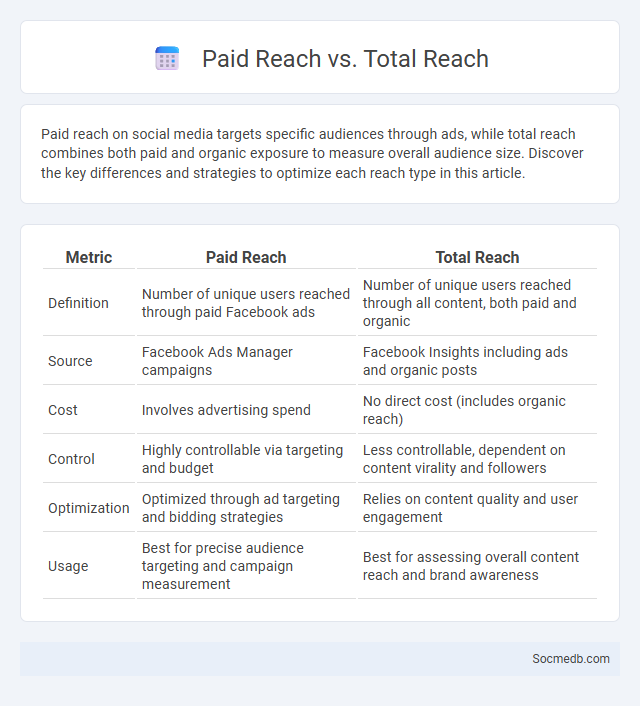
Photo illustration: Paid Reach vs Total Reach
Paid reach on social media targets specific audiences through ads, while total reach combines both paid and organic exposure to measure overall audience size. Discover the key differences and strategies to optimize each reach type in this article.
Table of Comparison
| Metric | Paid Reach | Total Reach |
|---|---|---|
| Definition | Number of unique users reached through paid Facebook ads | Number of unique users reached through all content, both paid and organic |
| Source | Facebook Ads Manager campaigns | Facebook Insights including ads and organic posts |
| Cost | Involves advertising spend | No direct cost (includes organic reach) |
| Control | Highly controllable via targeting and budget | Less controllable, dependent on content virality and followers |
| Optimization | Optimized through ad targeting and bidding strategies | Relies on content quality and user engagement |
| Usage | Best for precise audience targeting and campaign measurement | Best for assessing overall content reach and brand awareness |
Understanding Paid Reach, Total Reach, and Organic Reach
Paid reach refers to the number of users who see your content as a result of paid promotions and advertisements on social media platforms. Total reach combines both paid and organic reach, representing the overall audience size exposed to your content within a specific timeframe. Organic reach measures the number of users who view your posts without any paid distribution, reflecting the natural engagement and visibility of your content.
Definitions: What is Paid Reach?
Paid reach refers to the total number of unique users who see a brand's content as a result of paid advertising campaigns on social media platforms. It measures the audience exposure gained through sponsored posts, promoted tweets, or paid ads rather than organic distribution. Monitoring paid reach helps businesses assess the effectiveness of their advertising budget and optimize targeting strategies for maximum visibility.
Definitions: What is Total Reach?
Total Reach refers to the total number of unique individuals who have seen your content across all social media platforms during a specific period. It measures the overall exposure of your posts, combining impressions from organic, paid, and viral sources to provide a comprehensive view of audience engagement. Understanding Total Reach helps you evaluate the effectiveness of your social media strategy and how well your message resonates with your target audience.
Paid Reach vs. Total Reach: Key Differences
Paid reach on social media refers to the number of users who see your content as a result of paid promotions, such as ads or boosted posts, directly targeting specific demographics or interests. Total reach combines both paid reach and organic reach, which includes users who view your content naturally through shares, follows, or engagement without paid influence. Understanding the distinction between paid reach and total reach is essential for accurately measuring campaign effectiveness and optimizing budget allocation on platforms like Facebook, Instagram, and Twitter.
How Paid Reach Impacts Your Marketing Strategy
Paid reach significantly amplifies your marketing strategy by targeting specific audiences with precision, ensuring that your content reaches potential customers beyond organic followers. Leveraging paid reach data allows for optimized ad spend, improved engagement rates, and measurable ROI, crucial for adjusting campaign effectiveness. Integrating paid reach into your social media plan enables a strategic balance between organic growth and paid amplification, driving brand visibility and conversions.
Measuring Total Reach: Methods and Metrics
Measuring Total Reach on social media involves analyzing key metrics such as impressions, unique users reached, and engagement rates to gauge the overall visibility of your content. Techniques include using platform analytics tools like Facebook Insights, Twitter Analytics, and third-party services that aggregate cross-channel data to provide a comprehensive overview. Your ability to track total reach accurately helps optimize content strategy and improve audience targeting for enhanced social media performance.
Advantages of Investing in Paid Reach
Investing in paid reach on social media significantly amplifies your content's visibility, ensuring it reaches a targeted and relevant audience beyond organic limits. This strategic approach enhances engagement rates, drives higher website traffic, and boosts conversion opportunities by leveraging platform-specific algorithms designed to prioritize paid content. Your brand gains measurable results through detailed analytics, allowing precise optimization and maximized return on investment.
Challenges in Tracking Reach Effectively
Social media platforms present significant challenges in tracking reach effectively due to algorithmic changes and privacy restrictions that limit access to accurate user data. Inconsistent metrics across platforms complicate the comparison and measurement of campaign performance, hindering marketers' ability to optimize strategies. Data discrepancies from third-party analytics tools further obscure true audience engagement and overall content visibility.
Best Practices for Maximizing Both Paid and Total Reach
To maximize both paid and total reach on social media, focus on targeting your audience with precision using advanced segmentation tools and leveraging lookalike audiences to expand your reach efficiently. Consistently create high-quality, engaging content that resonates with your audience while utilizing platform-specific ad formats and placements to optimize visibility. Your strategy should include regular performance analysis and A/B testing to refine campaigns and allocate budget toward the most effective channels for sustained growth and improved ROI.
Choosing the Right Reach Metric for Your Campaign
Choosing the right reach metric for your social media campaign is crucial to accurately measure audience engagement and campaign success. Focus on metrics like unique reach, impressions, and frequency to align with your campaign goals and target demographics. Your choice impacts how effectively you optimize content delivery and allocate budget for maximum influence.
 socmedb.com
socmedb.com